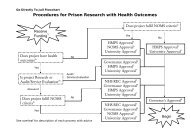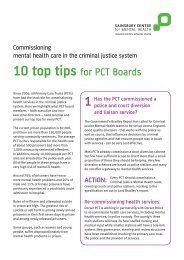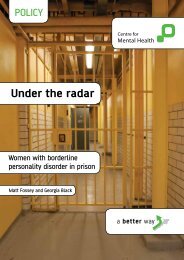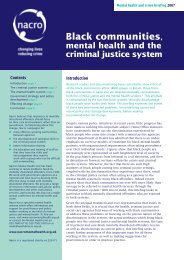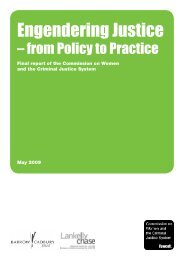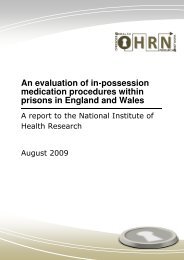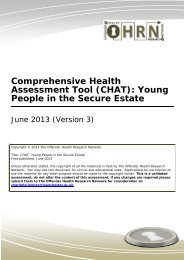<strong>Criminal</strong> <strong>justice</strong> <strong>liaison</strong> <strong>and</strong> <strong>diversion</strong> <strong>schemes</strong>: A focus on women offenderswith all the other service programmes, likecancer, like heart diseases, all the other bits<strong>and</strong> pieces… They all get dealt with first.Mental health comes way down thecommissioning list <strong>and</strong> within mentalhealth you have all those targets that youare performance-managed… Court <strong>diversion</strong>has not appeared in that. It barely got amention in the criminal <strong>justice</strong> carepathway… never mind a target.’CJLD <strong>schemes</strong>’ datafindingsData qualityWe collated local police arrest <strong>and</strong> sentencingdata <strong>and</strong> scheme monitoring data from 2005 toprovide an indication of the need for CJLD<strong>schemes</strong> for women offenders in different areas.From the outset it was clear that the extent <strong>and</strong>quality of routine monitoring data would vary. Anearlier Nacro survey 22 found that one in five<strong>schemes</strong> did not collect service level activity data,while two-fifths did not record details of clients’gender. As anticipated, much of this activity datawas paper-based.The quality <strong>and</strong> consistency of activity data wasgenerally poor <strong>and</strong> monitoring systems wereinadequate. The minimum data set proposed forthis study (see Box 2, page 11) representedcommon core data that were available across the<strong>schemes</strong>, according to screening <strong>and</strong> assessmenttools. However, only four <strong>schemes</strong> routinelytransferred these data onto an electronicdatabase, three had no electronic data at all, twogave us partial electronic data <strong>and</strong> one schemecould provide no activity data. As a result, theproportion of missing data was high, particularlyon items such as primary diagnosis <strong>and</strong> referralrecommendations. <strong>Criminal</strong> <strong>justice</strong> outcomeswere not easily available at eight of the <strong>schemes</strong>.Likewise, the outcome of referrals to communityservices were not recorded routinely.This meant that we were unable to draw anyconclusions about the recommendations made tothe court by CJLD <strong>schemes</strong> for women offenders<strong>and</strong> the proportion of recommendations taken upby courts, or the proportion of successfulreferrals from CJLD of women to hospital <strong>and</strong>community-based mental health services <strong>and</strong>criminal <strong>justice</strong> system interventions. Thesekinds of outcome data were not recordedroutinely by most <strong>schemes</strong>, making it very hardto judge the effectiveness of the <strong>schemes</strong>. Whatwe can say about the CJLD contacts <strong>and</strong> referralsources is limited. This dearth of monitoring datais an important finding in its own right.Nature <strong>and</strong> extent of contact byCJLD <strong>schemes</strong>We can say that the <strong>schemes</strong> were seeing onaverage 2% to 3% of the total number of offenderspassing through the police station <strong>and</strong> courts.This suggests a considerable level of unmet need.Surveys of the offender population haveconsistently found a high proportion with mentalhealth problems. 15There were 2,155 adult referrals to the nine CJLD<strong>schemes</strong> between January <strong>and</strong> December 2005,ranging from 16 to 688 referrals per scheme (themean was 239). Around three-quarters of referralsduring this period were made via police custody(n=1,123; 52%), probation (n=289; 13%) or thecourts (n=192; 9%).Four <strong>schemes</strong> operated at the police station. *Between January <strong>and</strong> December 2005 these policeforce areas came into contact with a total of49,666 arrestees. During the same period theCJLD <strong>schemes</strong> received 1,492 referrals, but notsolely from custody suites – equivalent to 3% ofthe arrestee population at these sites. The rate ofcontact was similar for female suspects (3.5%).The level of contact with the arrestee populationvaried by area from 4.7% in Scheme 9 to 1.4% inScheme 10.At all nine CJLD sites it was possible to gathercomparable data on court activity (though onlysix operated as court-based <strong>schemes</strong>). During2005, 85,893 defendants were sentenced by thecourts. The <strong>schemes</strong> in these areas received 2,155referrals – equivalent to 2.5% of the populationprocessed by the courts. As with the arresteedata, the rate of contact was almost identical forfemale defendants (2.6%), but with the level ofcontact varying considerably between areas, from0.8% in Scheme 1 to 4.9% in Scheme 7, thisscheme also engaged the highest proportion offemale defendants (7.7%).The most common reasons for making a referralwere unspecified mental health concerns (n=500),* Two <strong>schemes</strong> operated both at the police station <strong>and</strong> at the court stage.8
Mental health briefing 2008Table 2 Primary diagnosis for CJLD referrals requiring furtherintervention (%) (n=1146)35 32%16%3025201513%11% 11%1056%5%3%2% 2%1%0Substance useSerious <strong>and</strong> enduringmental illnessDepressionOtherPersonality disorderNo diagnosisLow level mentalhealth needsDual diagnosisLearning disabilityMissingSelf-harmself-harming (n=355), substance use (n=28) orother reasons (n=184). * The available activitydata from the nine sites suggests that less thanone-third (n=648) of those referred to CJLD<strong>schemes</strong> during 2005 had previous contact withpsychiatric services. ** In some cases CJLDworkers completed a full assessment with thereferrals they saw (n=820; 38%); however, wecannot be certain of the extent to which thishappened, as details on the type of assessmentundertaken were often missing.Over half the adults referred to the CJLD <strong>schemes</strong>were assessed as requiring further intervention(n=1146; 53%). *** Table 2 illustrates how substanceuse (n=362), SEMI (serious <strong>and</strong> enduring mentalillness, such as schizophrenia <strong>and</strong> bipolar/manicdepressive psychosis) (n=187) <strong>and</strong> depression(n=142) were the most common forms of primary* The reason for referral was not recorded in 51% of cases (n=1089).** Data on previous contact with psychiatric services was not recorded in 44%of cases (n=956).*** Data on referral recommendations were missing (including not known <strong>and</strong>not assessed) in 25% of cases (n=545).diagnosis made by CJLD workers followingassessment of need. The high rate of CJLDreferrals being identified with substance misuseproblems indicates some duplication of effort orthe potential for dual diagnosis of substancemisuse <strong>and</strong> mental health problems. Thisreinforces the need to establish links betweenCJLD <strong>schemes</strong> <strong>and</strong> DARS.How did the women seen by theCJLD <strong>schemes</strong> differ from the men?It is important to consider whether women’sexperiences of the CJLD <strong>schemes</strong> differed frommen’s <strong>and</strong> to underst<strong>and</strong> what factors wereimportant in shaping these experiences. Therewere a limited number of variables, for which wehad reasonable data, which we could hypothesiseas being potentially important factors (see Table 3overleaf).The women seen by the <strong>schemes</strong> were more likelythan men to be white; to have beenarrested/charged with a public order or violentoffence (but not section 136 detainees); <strong>and</strong>, to9




